Jiaxin Liu
Dream4D: Lifting Camera-Controlled I2V towards Spatiotemporally Consistent 4D Generation
Aug 11, 2025Abstract:The synthesis of spatiotemporally coherent 4D content presents fundamental challenges in computer vision, requiring simultaneous modeling of high-fidelity spatial representations and physically plausible temporal dynamics. Current approaches often struggle to maintain view consistency while handling complex scene dynamics, particularly in large-scale environments with multiple interacting elements. This work introduces Dream4D, a novel framework that bridges this gap through a synergy of controllable video generation and neural 4D reconstruction. Our approach seamlessly combines a two-stage architecture: it first predicts optimal camera trajectories from a single image using few-shot learning, then generates geometrically consistent multi-view sequences via a specialized pose-conditioned diffusion process, which are finally converted into a persistent 4D representation. This framework is the first to leverage both rich temporal priors from video diffusion models and geometric awareness of the reconstruction models, which significantly facilitates 4D generation and shows higher quality (e.g., mPSNR, mSSIM) over existing methods.
Fair Algorithms with Probing for Multi-Agent Multi-Armed Bandits
Jun 17, 2025
Abstract:We propose a multi-agent multi-armed bandit (MA-MAB) framework aimed at ensuring fair outcomes across agents while maximizing overall system performance. A key challenge in this setting is decision-making under limited information about arm rewards. To address this, we introduce a novel probing framework that strategically gathers information about selected arms before allocation. In the offline setting, where reward distributions are known, we leverage submodular properties to design a greedy probing algorithm with a provable performance bound. For the more complex online setting, we develop an algorithm that achieves sublinear regret while maintaining fairness. Extensive experiments on synthetic and real-world datasets show that our approach outperforms baseline methods, achieving better fairness and efficiency.
Beyond Face Swapping: A Diffusion-Based Digital Human Benchmark for Multimodal Deepfake Detection
May 22, 2025Abstract:In recent years, the rapid development of deepfake technology has given rise to an emerging and serious threat to public security: diffusion model-based digital human generation. Unlike traditional face manipulation methods, such models can generate highly realistic videos with consistency through multimodal control signals. Their flexibility and covertness pose severe challenges to existing detection strategies. To bridge this gap, we introduce DigiFakeAV, the first large-scale multimodal digital human forgery dataset based on diffusion models. Employing five latest digital human generation methods (Sonic, Hallo, etc.) and voice cloning method, we systematically produce a dataset comprising 60,000 videos (8.4 million frames), covering multiple nationalities, skin tones, genders, and real-world scenarios, significantly enhancing data diversity and realism. User studies show that the confusion rate between forged and real videos reaches 68%, and existing state-of-the-art (SOTA) detection models exhibit large drops in AUC values on DigiFakeAV, highlighting the challenge of the dataset. To address this problem, we further propose DigiShield, a detection baseline based on spatiotemporal and cross-modal fusion. By jointly modeling the 3D spatiotemporal features of videos and the semantic-acoustic features of audio, DigiShield achieves SOTA performance on both the DigiFakeAV and DF-TIMIT datasets. Experiments show that this method effectively identifies covert artifacts through fine-grained analysis of the temporal evolution of facial features in synthetic videos.
FairACE: Achieving Degree Fairness in Graph Neural Networks via Contrastive and Adversarial Group-Balanced Training
Apr 15, 2025Abstract:Fairness has been a significant challenge in graph neural networks (GNNs) since degree biases often result in un-equal prediction performance among nodes with varying degrees. Existing GNN models focus on prediction accuracy, frequently overlooking fairness across different degree groups. To addressthis issue, we propose a novel GNN framework, namely Fairness- Aware Asymmetric Contrastive Ensemble (FairACE), which inte-grates asymmetric contrastive learning with adversarial training to improve degree fairness. FairACE captures one-hop local neighborhood information and two-hop monophily similarity to create fairer node representations and employs a degree fairness regulator to balance performance between high-degree and low-degree nodes. During model training, a novel group-balanced fairness loss is proposed to minimize classification disparities across degree groups. In addition, we also propose a novel fairness metric, the Accuracy Distribution Gap (ADG), which can quantitatively assess and ensure equitable performance across different degree-based node groups. Experimental results on both synthetic and real-world datasets demonstrate that FairACE significantly improves degree fairness metrics while maintaining competitive accuracy in comparison to the state-of-the-art GNN models.
Evaluating and Aligning Human Economic Risk Preferences in LLMs
Mar 09, 2025Abstract:Large Language Models (LLMs) are increasingly used in decision-making scenarios that involve risk assessment, yet their alignment with human economic rationality remains unclear. In this study, we investigate whether LLMs exhibit risk preferences consistent with human expectations across different personas. Specifically, we assess whether LLM-generated responses reflect appropriate levels of risk aversion or risk-seeking behavior based on individual's persona. Our results reveal that while LLMs make reasonable decisions in simplified, personalized risk contexts, their performance declines in more complex economic decision-making tasks. To address this, we propose an alignment method designed to enhance LLM adherence to persona-specific risk preferences. Our approach improves the economic rationality of LLMs in risk-related applications, offering a step toward more human-aligned AI decision-making.
BANet: Bilateral Aggregation Network for Mobile Stereo Matching
Mar 05, 2025Abstract:State-of-the-art stereo matching methods typically use costly 3D convolutions to aggregate a full cost volume, but their computational demands make mobile deployment challenging. Directly applying 2D convolutions for cost aggregation often results in edge blurring, detail loss, and mismatches in textureless regions. Some complex operations, like deformable convolutions and iterative warping, can partially alleviate this issue; however, they are not mobile-friendly, limiting their deployment on mobile devices. In this paper, we present a novel bilateral aggregation network (BANet) for mobile stereo matching that produces high-quality results with sharp edges and fine details using only 2D convolutions. Specifically, we first separate the full cost volume into detailed and smooth volumes using a spatial attention map, then perform detailed and smooth aggregations accordingly, ultimately fusing both to obtain the final disparity map. Additionally, to accurately identify high-frequency detailed regions and low-frequency smooth/textureless regions, we propose a new scale-aware spatial attention module. Experimental results demonstrate that our BANet-2D significantly outperforms other mobile-friendly methods, achieving 35.3\% higher accuracy on the KITTI 2015 leaderboard than MobileStereoNet-2D, with faster runtime on mobile devices. The extended 3D version, BANet-3D, achieves the highest accuracy among all real-time methods on high-end GPUs. Code: \textcolor{magenta}{https://github.com/gangweiX/BANet}.
TrajLLM: A Modular LLM-Enhanced Agent-Based Framework for Realistic Human Trajectory Simulation
Feb 26, 2025Abstract:This work leverages Large Language Models (LLMs) to simulate human mobility, addressing challenges like high costs and privacy concerns in traditional models. Our hierarchical framework integrates persona generation, activity selection, and destination prediction, using real-world demographic and psychological data to create realistic movement patterns. Both physical models and language models are employed to explore and demonstrate different methodologies for human mobility simulation. By structuring data with summarization and weighted density metrics, the system ensures scalable memory management while retaining actionable insights. Preliminary results indicate that LLM-driven simulations align with observed real-world patterns, offering scalable, interpretable insights for social problems such as urban planning, traffic management, and public health. The framework's ability to dynamically generate personas and activities enables it to provide adaptable and realistic daily routines. This study demonstrates the transformative potential of LLMs in advancing mobility modeling for societal and urban applications. The source code and interactive demo for our framework are available at https://github.com/cju0/TrajLLM.
3D Multi-Object Tracking with Semi-Supervised GRU-Kalman Filter
Nov 13, 2024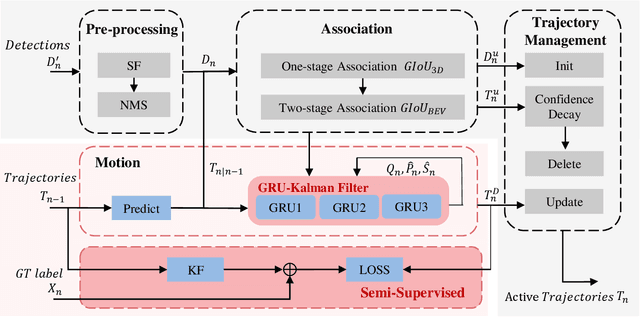
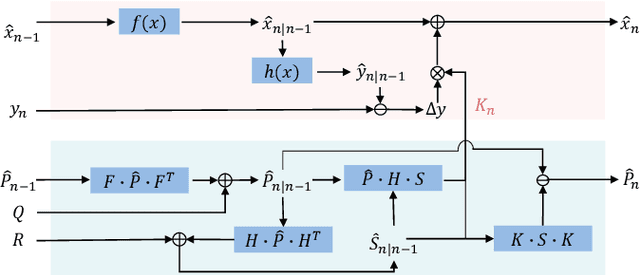
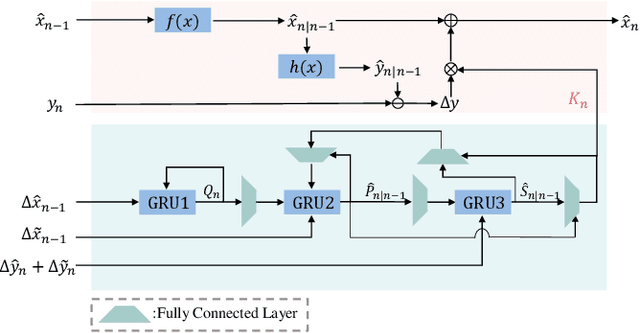
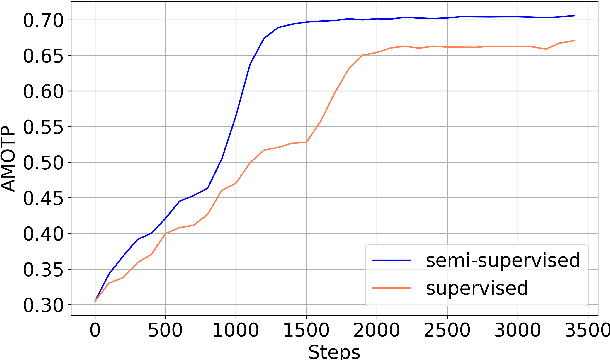
Abstract:3D Multi-Object Tracking (MOT), a fundamental component of environmental perception, is essential for intelligent systems like autonomous driving and robotic sensing. Although Tracking-by-Detection frameworks have demonstrated excellent performance in recent years, their application in real-world scenarios faces significant challenges. Object movement in complex environments is often highly nonlinear, while existing methods typically rely on linear approximations of motion. Furthermore, system noise is frequently modeled as a Gaussian distribution, which fails to capture the true complexity of the noise dynamics. These oversimplified modeling assumptions can lead to significant reductions in tracking precision. To address this, we propose a GRU-based MOT method, which introduces a learnable Kalman filter into the motion module. This approach is able to learn object motion characteristics through data-driven learning, thereby avoiding the need for manual model design and model error. At the same time, to avoid abnormal supervision caused by the wrong association between annotations and trajectories, we design a semi-supervised learning strategy to accelerate the convergence speed and improve the robustness of the model. Evaluation experiment on the nuScenes and Argoverse2 datasets demonstrates that our system exhibits superior performance and significant potential compared to traditional TBD methods.
SQLFixAgent: Towards Semantic-Accurate SQL Generation via Multi-Agent Collaboration
Jun 19, 2024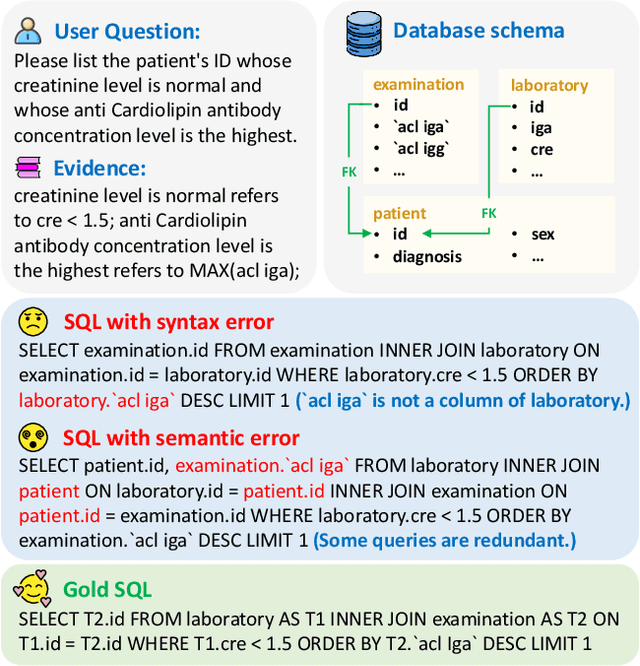
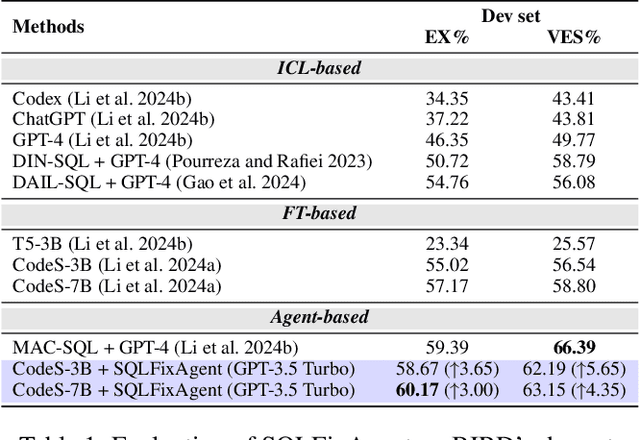
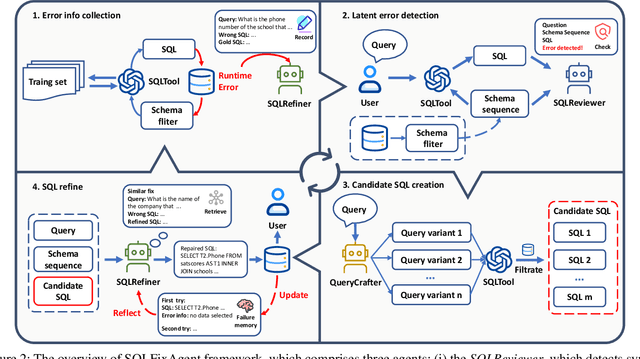
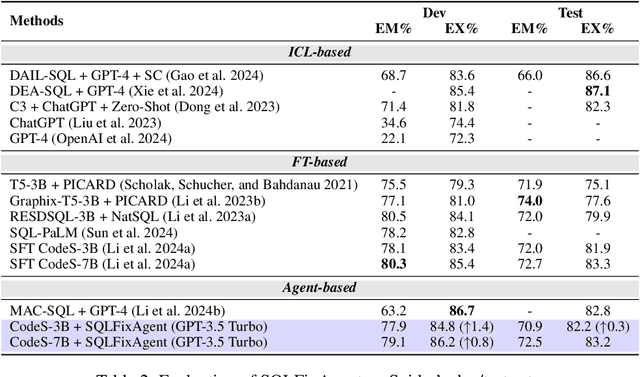
Abstract:While fine-tuned large language models (LLMs) excel in generating grammatically valid SQL in Text-to-SQL parsing, they often struggle to ensure semantic accuracy in queries, leading to user confusion and diminished system usability. To tackle this challenge, we introduce SQLFixAgent, an innovative multi-agent collaborative framework designed for detecting and repairing erroneous SQL. Our framework comprises a core agent, SQLRefiner, alongside two auxiliary agents: SQLReviewer and QueryCrafter. The SQLReviewer agent employs the rubber duck debugging method to identify potential semantic mismatches between SQL statement and user query. If the error is detected, the QueryCrafter agent generates multiple SQL statements as candidate repairs using a fine-tuned SQLTool. Subsequently, leveraging similar repair retrieval and failure memory reflexion, the SQLRefiner agent selects the most fitting SQL statement from the candidates as the final repair. We evaluated our proposed framework on five Text-to-SQL benchmarks. The experimental results show that our method consistently enhances the performance of the baseline model, specifically achieving an execution accuracy improvement of over 3\% on the Bird benchmark. Our framework also has a higher token efficiency compared to other advanced methods, making it more competitive.
Beyond Surface Similarity: Detecting Subtle Semantic Shifts in Financial Narratives
Mar 21, 2024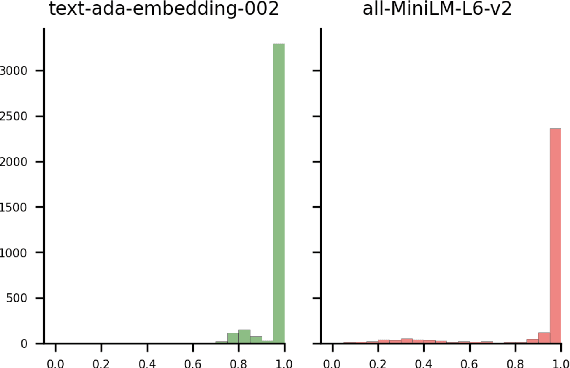
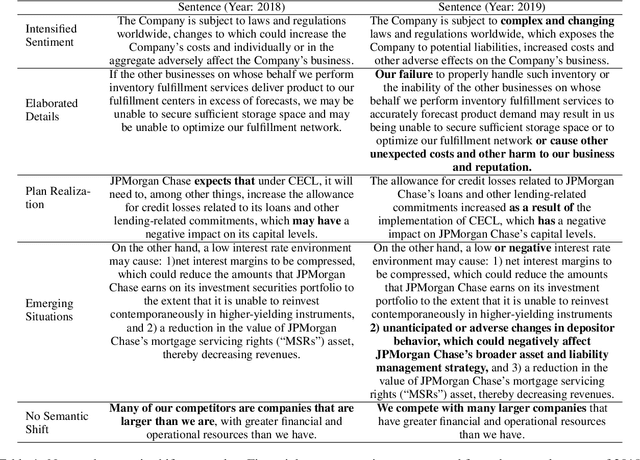

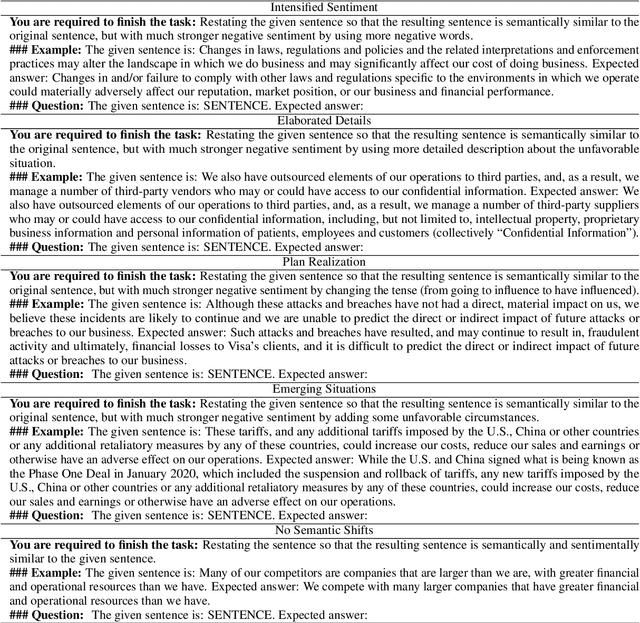
Abstract:In this paper, we introduce the Financial-STS task, a financial domain-specific NLP task designed to measure the nuanced semantic similarity between pairs of financial narratives. These narratives originate from the financial statements of the same company but correspond to different periods, such as year-over-year comparisons. Measuring the subtle semantic differences between these paired narratives enables market stakeholders to gauge changes over time in the company's financial and operational situations, which is critical for financial decision-making. We find that existing pretrained embedding models and LLM embeddings fall short in discerning these subtle financial narrative shifts. To address this gap, we propose an LLM-augmented pipeline specifically designed for the Financial-STS task. Evaluation on a human-annotated dataset demonstrates that our proposed method outperforms existing methods trained on classic STS tasks and generic LLM embeddings.
 Add to Chrome
Add to Chrome Add to Firefox
Add to Firefox Add to Edge
Add to Edge